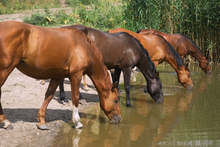The Virginia-Maryland Regional College of Veterinary Medicine (VMRCVM) issued an alert earlier this week to inform area horse owners of several cases of Potomac Horse Fever (PHF). The disease was originally discovered near the Potomac River in Maryland, but is now found throughout North America.

Rivers and streams - Source of Potomac horse fever
Potomac horse fever spreads to horses when they ingest infected snails or insects while grazing or drinking, and rainy weather in the mid-Atlantic region this year may have led to more infected snails.
© 2013 by April Raine
The statement from the VMRCVM explains that PHF is spread through a common parasite known as the freshwater fluke. In its developmental phase, the fluke infects aquatic snails and insects such as dragonflies and mayflies.
The infection can spread to horses when they ingest infected snails, snail slime or insects while grazing or drinking. Rainy weather in the mid-Atlantic region this year may have led to more infected snails and insects reaching horse farms, causing the recent cases.
Symptoms of PHF include fever, diarrhea, laminitis, decreased abdominal sounds and mild colic. In rare cases, fetal infection can cause abortion in pregnant mares that contract the disease. Infection is rare in foals.
The disease is not contagious from one horse to another, but if one horse is infected, it's important to take precautions to protect other horses on the farm.
The causative agent is present in the feces of experimentally-infected horses, but clinically ill horses are not contagious and can be housed with healthy horses.
Several inactivated, whole-cell vaccines based on the same strain of "N risticii" are commercially available. According to the Merck Health Manual, although vaccination has been reported to protect 78 percent of experimentally-infected ponies, it has been marginally protective in the field population of horses.
The failure of the vaccine has been attributed to the fact that at least 14 different strains exist in naturally occurring cases and so far the vaccines are not able to insure against all strains of the pathogen.
Vaccine failure may also be due to a lack of antibody protection at the site of exposure because the natural route of transmission has been determined to be oral ingestion of the disease-carrying organism. Reduction of the snail population in rivers and streams may help lessen sources of infection.
Horse owners are encouraged to talk to their veterinarians about whether or not using a PHF vaccine is warranted for their horse.
Preventive management strategies include turning stable lights off at night to avoid attracting insects and frequently scrubbing water buckets and outdoor troughs to prevent them from becoming breeding grounds for bugs
